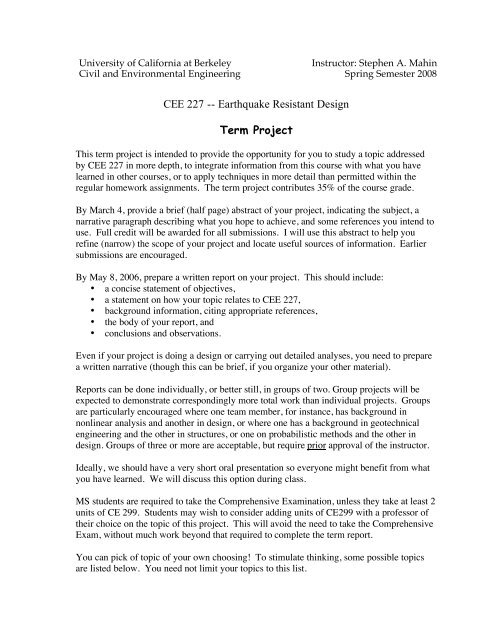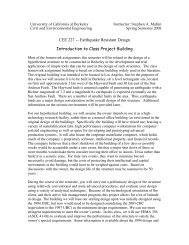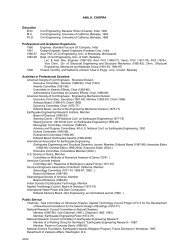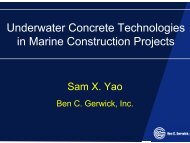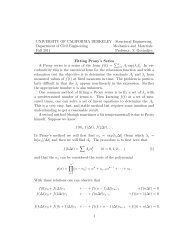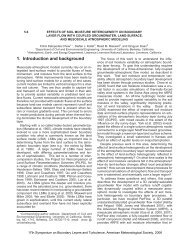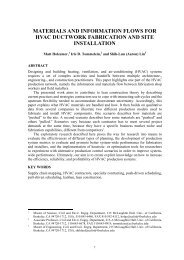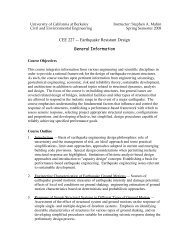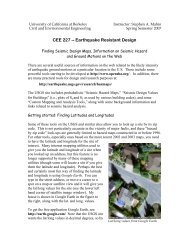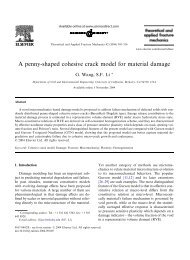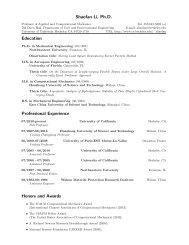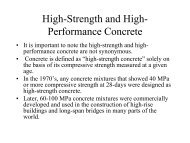CEE 227 -- Earthquake Resistant Design Term Project - Civil and ...
CEE 227 -- Earthquake Resistant Design Term Project - Civil and ...
CEE 227 -- Earthquake Resistant Design Term Project - Civil and ...
You also want an ePaper? Increase the reach of your titles
YUMPU automatically turns print PDFs into web optimized ePapers that Google loves.
University of California at Berkeley<br />
<strong>Civil</strong> <strong>and</strong> Environmental Engineering<br />
Instructor: Stephen A. Mahin<br />
Spring Semester 2008<br />
<strong>CEE</strong> <strong>227</strong> -- <strong>Earthquake</strong> <strong>Resistant</strong> <strong>Design</strong><br />
<strong>Term</strong> <strong>Project</strong><br />
This term project is intended to provide the opportunity for you to study a topic addressed<br />
by <strong>CEE</strong> <strong>227</strong> in more depth, to integrate information from this course with what you have<br />
learned in other courses, or to apply techniques in more detail than permitted within the<br />
regular homework assignments. The term project contributes 35% of the course grade.<br />
By March 4, provide a brief (half page) abstract of your project, indicating the subject, a<br />
narrative paragraph describing what you hope to achieve, <strong>and</strong> some references you intend to<br />
use. Full credit will be awarded for all submissions. I will use this abstract to help you<br />
refine (narrow) the scope of your project <strong>and</strong> locate useful sources of information. Earlier<br />
submissions are encouraged.<br />
By May 8, 2006, prepare a written report on your project. This should include:<br />
• a concise statement of objectives,<br />
• a statement on how your topic relates to <strong>CEE</strong> <strong>227</strong>,<br />
• background information, citing appropriate references,<br />
• the body of your report, <strong>and</strong><br />
• conclusions <strong>and</strong> observations.<br />
Even if your project is doing a design or carrying out detailed analyses, you need to prepare<br />
a written narrative (though this can be brief, if you organize your other material).<br />
Reports can be done individually, or better still, in groups of two. Group projects will be<br />
expected to demonstrate correspondingly more total work than individual projects. Groups<br />
are particularly encouraged where one team member, for instance, has background in<br />
nonlinear analysis <strong>and</strong> another in design, or where one has a background in geotechnical<br />
engineering <strong>and</strong> the other in structures, or one on probabilistic methods <strong>and</strong> the other in<br />
design. Groups of three or more are acceptable, but require prior approval of the instructor.<br />
Ideally, we should have a very short oral presentation so everyone might benefit from what<br />
you have learned. We will discuss this option during class.<br />
MS students are required to take the Comprehensive Examination, unless they take at least 2<br />
units of CE 299. Students may wish to consider adding units of CE299 with a professor of<br />
their choice on the topic of this project. This will avoid the need to take the Comprehensive<br />
Exam, without much work beyond that required to complete the term report.<br />
You can pick of topic of your own choosing! To stimulate thinking, some possible topics<br />
are listed below. You need not limit your topics to this list.
<strong>CEE</strong> <strong>227</strong> – <strong>Term</strong> <strong>Project</strong> 2<br />
Related to design of new structures (See later sections on Isolation, etc.)<br />
Redesign the class project building (or another structure you find in the literature)<br />
<strong>and</strong> compare your redesign <strong>and</strong> its performance with those of the original structure.<br />
Some ideas would be to consider:<br />
• Modified moment frames for improved ductility using (FEMA350, AISC<br />
441, AISC 353) “prequalified” details.<br />
• Modified moment frames (configuration (number of frames, bay spacing,<br />
member depths, etc.) <strong>and</strong> proportioning (panel zone vs. beam yielding) to<br />
improve performance<br />
• Modified braced frames (to help control drift), including bucking restrained<br />
braces, friction or other types of hysteretic devices.<br />
• Supplemental viscous damping energy dissipation systems (viscous), for<br />
example, looking at the effect of different powers than one for velocity.<br />
• Seismic isolation of various types to limit damage in the superstructure.<br />
• Special bracing elements that would tend to make a structure re-center<br />
following a major earthquake, such as hydraulic springs by Jarret, shape<br />
memory alloys, or prestressed friction devices (e.g., see Christopolous). The<br />
hysteretic characteristics are pinched in a flagpole shape as shown.<br />
Use of PBE procedure in FEMA 350 to design the homework building more<br />
rationally <strong>and</strong> evaluate the confidence we have in it. There are numerous levels of<br />
analytical methods <strong>and</strong> performance objectives that can be addressed with this<br />
methodology.<br />
Application of course concepts to other types of structures (bridges, offshore<br />
structures, etc.)<br />
What happens if the foundations of a structure are allowed to uplift during an<br />
earthquake. Consider a structure like a braced frame or a narrow moment frame<br />
where there is net uplift on the footings, or a wider mat or spread foundation where<br />
there is only partial uplift along the edges of the foundation. Recently, architects like<br />
Renzo Piano have designed structures where this is an explicit design feature <strong>and</strong><br />
viscous dampers (or perhaps, as an alternative, buckling restrained braces could be<br />
used) are included in the uplifting columns to help dissipate energy.<br />
Application of issues related to soil-structure interaction (for example, the simplified<br />
methods outlined in FEMA 368) to design. When is this important, does it help (yes)<br />
or hurt?
<strong>CEE</strong> <strong>227</strong> – <strong>Term</strong> <strong>Project</strong> 3<br />
What is the effect of considering vertical ground motions? Carry out analyses of<br />
some simple building systems with different heights or floor spans considering or<br />
ignoring the vertical component of excitation. Consider the change of the relative<br />
character of the vertical ground motions (or spectra) with distance <strong>and</strong> earthquake<br />
magnitude. Look at structures, such as long span systems, prestressed systems,<br />
cantilever systems, etc., where vertical motions may generally expected to be<br />
important.<br />
Some architects are building new structures that are not uniform with height.<br />
Explore design issues related to these systems. For instance, see the figures below.<br />
Similarly, many architects are building systems that are not typical rectangular<br />
frames. Explore design issues related to such systems. For instance, see the figures<br />
shown below.<br />
Elevation<br />
Plan View<br />
No Vertical Columns
<strong>CEE</strong> <strong>227</strong> – <strong>Term</strong> <strong>Project</strong> 4<br />
For high-rise structures, a number of structural features are used to help reduce<br />
lateral displacements. These include truss belts, outriggers <strong>and</strong> mega-trusses (see<br />
below). How do such structures behave compared to traditional strong-column,<br />
weak girder designs? What approaches are can be used to design these for ductile<br />
behavior?<br />
Often tall buildings in the US like the ones shown above are designed such that they<br />
are relatively non-redundant <strong>and</strong> a single concrete core provides lateral load<br />
resistance. What special requirements might someone use to improve confidence in<br />
achieving acceptable performance?<br />
Tuned mass dampers have been suggested for improving seismic response. However,<br />
it is difficult or costly to add sufficient mass <strong>and</strong> damping for the tuned mass.<br />
Recently, several projects have been built around the world where the design places<br />
a plane of seismic isolation at about two thirds the height of the building, <strong>and</strong> the top<br />
third of the building is used as the tuned mass <strong>and</strong> the isolators allow lateral<br />
movement of the upper mass <strong>and</strong> provide damping. Are there special requirements<br />
for the period range of the overall structure (limited to low rise or to very tall<br />
buildings), does the upper part of the structure need to be stiff <strong>and</strong> elastic, can the<br />
two parts of the structure yield (in one instance, lower part was allowed to yield<br />
significantly, <strong>and</strong> it was shown that the lower part performed better than if the upper<br />
part of the structure were not there).<br />
Seismic<br />
Isolators<br />
Fluid sloshing dampers are used at the top of tall buildings to control vibrations due<br />
to wind <strong>and</strong> small earthquakes. How do these work? Can they be used for larger<br />
earthquakes?
<strong>CEE</strong> <strong>227</strong> – <strong>Term</strong> <strong>Project</strong> 5<br />
Related to detailed evaluation procedures for existing buildings: FEMA<br />
356/351<br />
Review methodology <strong>and</strong> comment on how it relates to class. Compare two or more<br />
analysis methods described, such as elastic versus nonlinear static methods,<br />
nonlinear static <strong>and</strong> dynamic methods, etc. Compare methodology in FEMA<br />
356/ASCE 41 <strong>and</strong> FEMA 351 for establishing acceptance criteria <strong>and</strong> for describing<br />
acceptability of structure. Note you cannot do all of this. Buildings available may<br />
include:<br />
• 1994 UBC designed SAC buildings (3, 9 or 20 stories) located in Seattle,<br />
Boston or Los Angeles<br />
• Soda Hall (pre-Northridge welded steel moment frame, lots of data <strong>and</strong> some<br />
OpenSEES models exist)<br />
• Van Nuys Holiday Inn (reinforced concrete frame, a PEER testbed with<br />
considerable information on it)<br />
• McLaughlin Hall (a preliminary seismic report exists)<br />
• Sather Tower (whoops, it sits on a mat foundation only as wide as the tower,<br />
plus some other issues. A report exists on a preliminary investigation <strong>and</strong><br />
additional professional help is available from recent CE <strong>227</strong> grads)<br />
• What about the early seismic retrofits on campus (do the student housing<br />
units (retrofit to 3/4 of the 1988 UBC need to be re-retrofit?)<br />
• Applications of bracing, supplemental viscous damping or seismic isolation<br />
as a retrofit of steel or reinforced concrete frames.<br />
• Addition of tuned mass dampers or sloshing dampers to add “damping” to the<br />
structure to improve response.<br />
• Preservation of historic monuments <strong>and</strong> structures. For example,<br />
preservation of European cathedrals or monuments located around the world<br />
(Tikal, Pompei, Stonehenge, etc.). Cyark is working to move from scanning<br />
of these structures to automatically make analysis models, <strong>and</strong> from there to<br />
evaluate monuments (<strong>and</strong> figure out how to fix them so they will not collapse<br />
in earthquakes). See http://archive.cyark.org/index.php<br />
Drawings of buildings on the Berkeley campus are available through capital<br />
projects<br />
FEMA 547 discusses techniques for retrofitting various systems like those<br />
described above.<br />
Analytical / behavior related studies (can be analyses you do, a critical review<br />
of literature, or a combination of both)<br />
• Assess methods to predict <strong>and</strong> improve response of structures, which exhibit strong<br />
geometric nonlinearities (P-Δ effects) - SDOF or MDOF systems.<br />
• Effect of strong motion duration <strong>and</strong> aftershocks on structural response.
<strong>CEE</strong> <strong>227</strong> – <strong>Term</strong> <strong>Project</strong> 6<br />
• Identification of damaging features of ground motions (how to measure damage<br />
(peak displacement, drift, cumulative plastic displacement, Park-Ang models,<br />
fracture mechanics/low cycle fatigue, etc.), <strong>and</strong> what aspects of a ground motion can<br />
be used as an index of damage potential (peak acceleration, peak velocity, total<br />
energy input, instantaneous power, etc.)<br />
• Why is response relatively insensitive to various hysteretic characteristics (strength,<br />
pinching during loading, etc.) <strong>and</strong> sensitive to others (negative post-yield stiffness,<br />
unloading stiffness)<br />
• Sensitivity of computed response to modeling assumptions (steel: modeling of panel<br />
zones, floor systems, inclusion on frames not intentionally expected to be part of the<br />
lateral load resisting system, material property variability, etc.; reinforced concrete:<br />
EI eff , slab effects, etc.)<br />
• Effect of bidirectional excitations on inelastic response. Effect of vertical ground<br />
motions on structural response. For example, what are the forces in a column where<br />
the column is part of braced frames running in orthogonal directions? What are the<br />
forces in columns in moment frames where the column is part of frames running in<br />
two directions? What are the forces where the column is only part of one frame, but<br />
must move in the other direction due to compatibly of motion imposed by the floor<br />
diaphragms?<br />
• Assessment or studies related to collapse prediction of structures (incremental<br />
dynamic analysis methods in FEMA 350-352, fragility curves from PEER/ATC 58)<br />
• Damage associated with nonstructural components. Methods to limit damage to<br />
various types of nonstructural elements, components <strong>and</strong> contents. Damage cost<br />
estimates. Numerical models for various types of nonstructural elements.<br />
• Dynamic response of heavy equipment resting on a floor slab, like large refrigerators<br />
or computer st<strong>and</strong>s.<br />
• Detailed probabilistic methods for characterizing performance <strong>and</strong> loss.<br />
• Dynamic response of long period structures to near fault motions (i.e., wave<br />
propagation effects that may concentrate damage near the top or bottom of a<br />
structure (or elsewhere) as waves start or reinforce one another).<br />
Programming<br />
• Develop a program to carry out simple analysis of multiple degree of freedom shear<br />
buildings (an extension of BiSpec)<br />
• Web-based Java (script) tools to implement various parts of course (like the attenuation<br />
tool on the course web site)<br />
• Optimization<br />
Seismic Isolation
<strong>CEE</strong> <strong>227</strong> – <strong>Term</strong> <strong>Project</strong> 7<br />
1. Investigate the effects of various nonlinear models on the floor spectra observed in a<br />
generic multi-story isolated building, subjected to a suite of acceleration records.<br />
Possible nonlinear models include bilinear, Bouc-Wen, viscoplastic Kelvin-type model,<br />
etc. Of interest would be the effect of changing parameters of these models on frequency<br />
content of acceleration histories at different floor levels.<br />
2. Complete the design of the building represented in the homework assignments using<br />
nonlinear response history analysis, which is how virtually isolated buildings are<br />
ultimately designed. Make this design for a specific isolation system, <strong>and</strong> select bearings<br />
based on actual axial loads in the building. This involves the selection of a suite of<br />
acceleration records compatible with a site-specific design spectrum.<br />
3. Current building code provisions m<strong>and</strong>ate the scaling of ground motions to 1.3 times the<br />
design spectrum to account for bidirectional loading. This is likely quite conservative,<br />
<strong>and</strong> of interest would be the development of an appropriate scaling factor based on a set<br />
of recorded ground motions (i.e. what is the increase in peak isolator displacement when<br />
bidirectional excitation is applied compared to unidirectional.)<br />
4. The building code requires isolated buildings to be designed such that the bearings can<br />
resist displacement resulting from a 2500-yr return period seismic event. This forces the<br />
designer to use either a) stiff bearings, thereby reducing the isolation effect or b) large<br />
amounts of hysteretic <strong>and</strong>/or viscous damping. These adversely effect the performance<br />
in small <strong>and</strong> moderate seismic events. Investigate methods of achieving superior<br />
performance under moderate levels of seismic excitation without having detrimental<br />
performance of the isolation system in a very rare event.<br />
5. Near fault effects have long been considered to be potentially detrimental to isolated<br />
buildings, <strong>and</strong> probabilistic spectra for near fault sites estimate very large spectral<br />
displacements in the long period range. Using a suite of near fault motions from the<br />
PEER Strong Motion Catalog (http://peer.berkeley.edu/smcat) investigate the response<br />
of a bilinear SDOF model of an isolated building.<br />
6. Investigate the effect of variability in isolator properties on the response of the<br />
superstructure. This could be from Monte Carlo Simulation<br />
7. Perform a literature review of isolation devices with respect to velocity dependence.<br />
Discuss potential nonlinear viscous models to capture this behavior.<br />
8. Typically, isolation is recommended for relatively stiff, short period structures, <strong>and</strong><br />
isolator properties are selected so that the isolated period <strong>and</strong> fixed base period of the<br />
system are well separated. This clearly is not necessary, <strong>and</strong> in Japan, there is<br />
considerable isolation of tall buildings, where the fixed base period of the building is<br />
longer than the effective period of the structure.<br />
This form of isolation has many important advantages for tall buildings. Three 40 story<br />
or more tall buildings are currently under design in California considering isolation.<br />
Carry out a simplified (say SDOF per story) parametric study to investigate the behavior<br />
of this type of system.
<strong>CEE</strong> <strong>227</strong> – <strong>Term</strong> <strong>Project</strong> 8<br />
Passive Damping<br />
1. Study the behavior of buildings equipped with linear vs. nonlinear viscous dampers.<br />
Discuss potential benefits <strong>and</strong> drawbacks of each type of device.<br />
2. Compare the performance of a building designed a) using steel moment frame with<br />
linear viscous dampers <strong>and</strong> b) using steel buckling-restrained braced frames.<br />
Specifically, look at the dem<strong>and</strong> parameters of floor acceleration/spectra <strong>and</strong> peak<br />
interstory drift.<br />
3. Various hysteretic characteristics might be obtained for viscous dampers were Cd <strong>and</strong><br />
alpha depend on position <strong>and</strong> direction of the damper. For example, a damper that<br />
makes it easier to return to the origin, <strong>and</strong> easy to initially move, but progressively<br />
harder to move away from the origin (with a limiting force), may achieve a type of self<br />
centering properties.<br />
4. Viscous <strong>and</strong> hysteretic dampers are often placed in the outrigger or top cap frames<br />
shown on page 4. What characteristics should these dampers have?<br />
5. Some recent work has been done to design two adjacent buildings with viscous dampers<br />
between the two, so that the relative velocity results in considerable damping. A study<br />
on this could be quite interesting. For example, if the two buildings have identical<br />
properties, the buildings may move in sych <strong>and</strong> there will be little supplemental<br />
damping. Thus, there must be an optimal relation between the dynamic <strong>and</strong> mechanical<br />
properties of the two coupled buildings.<br />
Other dynamic loading<br />
• Blast-resistant design<br />
• Progressive collapse prevention (in Europe, this topic is now termed robust design)<br />
• Extreme wind storms
<strong>CEE</strong> <strong>227</strong> – <strong>Term</strong> <strong>Project</strong> 9<br />
Recent CE <strong>227</strong> TERM PAPER TITLES<br />
Subject<br />
Impact of<br />
nonstructural<br />
elements<br />
Redesign of Class<br />
Homework <strong>Project</strong><br />
Building<br />
Seismic Evaluation of<br />
Specific Buildings<br />
Seismic Response<br />
Studies <strong>and</strong> Basic<br />
<strong>Design</strong> Issues<br />
Seismic Isolation <strong>and</strong><br />
Supplemental Energy<br />
Dissipation<br />
Seismic Hazard<br />
Analysis<br />
Blast, Progressive<br />
Collapse, <strong>and</strong> Wind<br />
Related Dynamic<br />
Issues<br />
Title<br />
Reducing Nonstructural <strong>Earthquake</strong> Damage to Buildings<br />
Homework <strong>Project</strong> Redesign (Complete confidence evaluation <strong>and</strong><br />
member selection for several alternative designs)<br />
System Capacities According to Various Conditions [Pushover analyses<br />
of 8 different redesigns considering two different computer programs]<br />
Structural Recommendations for <strong>Design</strong> of Major Research Office<br />
Building in High Seismic Region [13 different redesigns included]<br />
Seismic Evaluation of the Unit Two Residence Halls<br />
FEMA 310 Tier 1 Evaluation of UC Berkeley MLK Student Center<br />
Union Building<br />
Seismic Response Analysis of Sather Tower<br />
Estimation of the Rocking Overturning of the Sather Tower<br />
Seismic Performance Analysis <strong>and</strong> <strong>Design</strong> Verification of the EH&S<br />
Hazardous Materials Facility<br />
Seismic Stability of Japanese Wooden Pagodas<br />
Mitigating Seismic Hazards in Developing Countries<br />
Pinched Hysteresis Loops & Response Spectra<br />
Use of Flag-Pole Shaped Hysteretic Loops to Reduce Residual<br />
Displacements following <strong>Earthquake</strong>s<br />
Effect of Vertical Ground Accelerations on Single Steel Moment Frames<br />
with Varying Aspect Ratios<br />
Improvements in Seismic Performance of Precast Segmental Bridges<br />
[results in Flag-pole type hysteretic shapes]<br />
Nonlinear Response of Various Offshore Jacket Platforms using Topcat<br />
Analysis of a Three-Story Frame using Time History <strong>and</strong> Reliability<br />
Methods<br />
Seismic Performance Evaluation using Nonlinear Analyses of an Exterior<br />
Frame of the Hearst Memorial Mining Building <strong>and</strong> a Three-Story Steel<br />
Moment Frame<br />
Base Condition Evaluation of the Berkeley Biotech Research Facility<br />
Response of Base Isolated Bridges to Pulse Excitations<br />
Supplemental Viscoelastic Damping in Light Frames: State of the<br />
Technology <strong>and</strong> a Look at the Future<br />
Passive Energy Dissipation Devices<br />
Probabilistic Seismic Hazard Analysis<br />
Probabilistic Seismic Hazard Analysis of 2754 Piedmont Avenue<br />
Seismic Hazard Analysis Using a Probabilistic Approach<br />
Blast <strong>Resistant</strong> <strong>Design</strong><br />
Mitigation of Blast Effects on a Building<br />
A Comparison of Dynamic <strong>and</strong> Equivalent Static Analysis Procedures for<br />
Typical Low- <strong>and</strong> High-rise Steel Moment Frame Buildings


